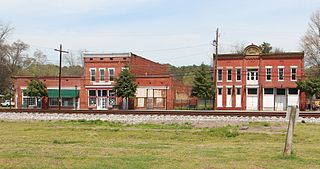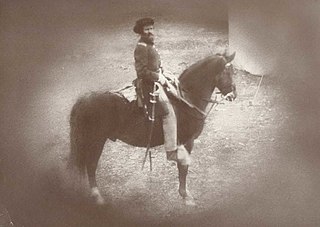
Kingston is a village in Bartow County, Georgia, United States. The population was 722 at the 2020 census.

The Battle of Atlanta took place during the Atlanta Campaign of the American Civil War on July 22, 1864, just southeast of Atlanta, Georgia. Continuing their summer campaign to seize the important rail and supply hub of Atlanta, Union forces commanded by William Tecumseh Sherman overwhelmed and defeated Confederate forces defending the city under John Bell Hood. Union Major General James B. McPherson was killed during the battle, the second-highest-ranking Union officer killed in action during the war. Despite the implication of finality in its name, the battle occurred midway through the Atlanta campaign, and the city did not fall until September 2, 1864, after a Union siege and various attempts to seize railroads and supply lines leading to Atlanta. After taking the city, Sherman's troops headed south-southeastward toward Milledgeville, the state capital, and on to Savannah with the March to the Sea.

The Battle of Ezra Church, also known as the Battle of Ezra Chapel and the Battle of the Poor House saw Union Army forces under Major General William T. Sherman fight Confederate States Army troops led by Lieutenant General John B. Hood in Fulton County, Georgia during the Atlanta campaign in the American Civil War. Sherman sent Oliver Otis Howard's Union Army of the Tennessee circling around the west side of Atlanta with the purpose of cutting the Macon and Western Railroad. Hood countered the move by sending two corps commanded by Stephen D. Lee and Alexander P. Stewart to block the move. Before Howard's troops reached the railroad, the Confederates launched several attacks on them that were repulsed with heavy losses. Despite the tactical defeat, the Confederates prevented their foes from blocking the railroad.
The Army of the Ohio was the name of two Union armies in the American Civil War. The first army became the Army of the Cumberland and the second army was created in 1863.
The Battle of Utoy Creek was fought August 4–7, 1864, during the Atlanta Campaign of the American Civil War. Maj. Gen. William T. Sherman's Union armies had partially encircled the city of Atlanta, Georgia, which was being held by Confederate forces under the command of General John Bell Hood. Sherman had at this point adopted a strategy of attacking the railroad lines into Atlanta, hoping to cut off his enemies' supplies. This was the third direct attack on Confederate positions during the campaign and the effect of success would have ended the siege and won Atlanta on 6 August 1864.
Sandtown is a neighborhood located southwest of Atlanta, Georgia.
There were several historic mills around the metro Atlanta area, for which many of its current-day roads are still named. Most of the mills date back to the 1820s and 1830s, and were built along the area's many streams. The locations of many of these mills are shown on a map of 1875 showing U. S. military operations around Atlanta in 1864. This map is now located in the U. S. Library of Congress but can be seen on the webpage linked here.

Lemuel Pratt Grant (1817–1893) was an American engineer and businessman. He was Atlanta's quintessential railroad man as well as a major landowner and civic leader. In railroads he served as a laborer, chief engineer, speculator and executive all over the South. As part of his speculation, he owned enormous tracts of land in strategic areas. For example, at one point he owned more than 600 acres (240 ha) in what is now Atlanta. He designed and built Atlanta's defenses during the American Civil War and afterwards became an important civic leader: donating the land for Grant Park, Atlanta's first large park, and serving as councilman and on various boards and committees. His mansion is one of only four remaining original antebellum houses in the city of Atlanta.

Cascade Heights is an affluent neighborhood in southwest Atlanta. It is bisected by Cascade Road, which was known as the Sandtown Road in the nineteenth century. The road follows the path of the ancient Sandtown Trail which ran from Stone Mountain to the Creek village of Sandtown on the Chattahoochee River and from there on into Alabama. Ironically, the name lived on even after the Indians were expelled in the 1830s.
The Battle of Brown's Mill was fought July 30, 1864, in Coweta County, Georgia, during the Atlanta Campaign of the American Civil War. Edward M. McCook's Union cavalry, on a daring raid to sever communications and supply lines in south-central Georgia, was defeated near Newnan, Georgia, by Confederate forces under Joseph Wheeler. The failure of McCook's column and a concurrent ill-fated raid by George Stoneman forced William T. Sherman to lay siege to the city of Atlanta.

The city of Atlanta, Georgia, in Fulton County, was an important rail and commercial center during the American Civil War. Although relatively small in population, the city became a critical point of contention during the Atlanta Campaign in 1864 when a powerful Union Army approached from Union-held Tennessee. The fall of Atlanta was a critical point in the Civil War, giving the North more confidence, and leading to the re-election of President Abraham Lincoln and the eventual dissolution of the Confederacy. The capture of the "Gate City of the South" was especially important for Lincoln as he was in a contentious election campaign against the Democratic opponent George B. McClellan.

The 104th Ohio Infantry Regiment, sometimes 104th Ohio Volunteer Infantry, was an infantry regiment in the Union army during the American Civil War. It played a conspicuous role at the Battle of Franklin during the 1864 Franklin–Nashville campaign, where six members later received the Medal of Honor, most for capturing enemy flags.
15th Indiana Battery Light Artillery was an artillery battery that served in the Union Army during the American Civil War.
The 22nd Indiana Battery Light Artillery was an artillery battery that served in the Union Army during the American Civil War.

The Trout House was one of three hotels in antebellum Atlanta, Georgia, along with the Atlanta Hotel and Washington Hall. It was built in 1849 by Jeremiah F. Trout. It was a four-story brick building at the southwest corner of Decatur and Pryor Streets, facing the union depot and State Square.

The Judge William Wilson House was an antebellum house in Atlanta, Georgia. It was built on land in a community west of Atlanta that was then called Adamsville which Wilson had inherited from his father William "Dollar Mill" Wilson (1775–1839) in 1839, and as the area around it developed came to be located in the Fairburn Heights neighborhood, a suburban area west of the Perimeter (I-285). At the end, it was one of only a few remaining antebellum structures still standing in its original location within the Atlanta city limits.

The Leyden House was one of Atlanta's most historic homes. It was located on 124 Peachtree Street NE between Cain and Ellis streets.

Utoy, Georgia was a small village located along Utoy Creek in present-day Fulton County, Georgia, USA. The vicinity, now part of metropolitan Atlanta, was the scene of the August 1864 Battle of Utoy Creek during the American Civil War and is today the site of Utoy Indian Village, a tourist center with renditions of historic Native-American structures and which offers a "Civil War Battlefield Tour."

The 5th Regiment Indiana Volunteer Cavalry was a cavalry regiment that served in the Union Army during the American Civil War.












